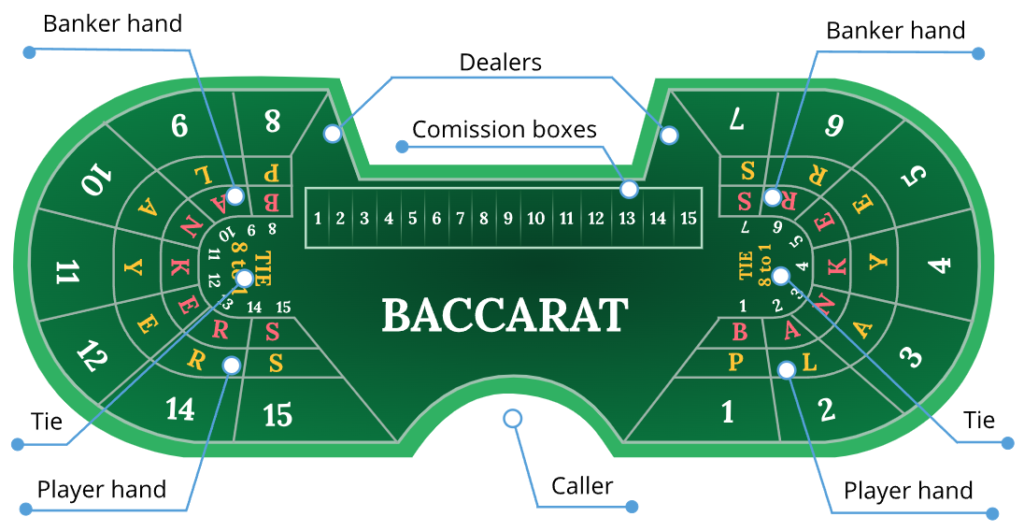- Baccarat shall be played with six to eight decks of cards that are identical in appearance and two cover cards. The decks of cards opened for use at a Baccarat table shall be changed after the play of each dealing shoe.
- Banker vs. Player: Regardless of how many people are playing, only two hands are dealt. One is designated the banker hand, the other is the player hand. Any customer may bet on either hand, with the exception that the customer holding the shoe in the full-scale game must either bet banker or pass the shoe. Do not think of the bank hand as belonging to the house or the player hand belonging to the bettor. To avoid confusion, we’ll refer to baccarat “bettors” or “customers” rather than “players.”
- It Began in Italy. The origins are still debated today, but most believe the game of baccarat was created in Italy in the 1400s by a man named Felix Falguiere or Falguiere in. He called the game “baccara,” Italian for “zero,” because all the tens and face cards were worth zero.
- In baccarat, cards have a point value: the 2 through 9 cards in each suit are worth face value (in points); the 10, jack, queen, and king have no point value (i.e. are worth zero); aces are worth 1 point; jokers are not used. Hands are valued according to units digit of the sum of their constituent cards. For example, a hand consisting of 2 and 3 is worth 5, but a hand consisting of 6 and 7 is worth 3 (i.e., the 3 being the units digit in the combined points total of 13).The highest possible hand value in baccarat is therefore nine.
How to play Baccarat?
Baccarat is an exciting game, full of suspense and intrigue! Baccarat is both simple to learn and play. A game of baccarat has three possible outcomes: Player win, Banker win, and tie. Note that “Banker” does not refer to the house. Participants in the game have the option to bet on either the player or bankers hand.


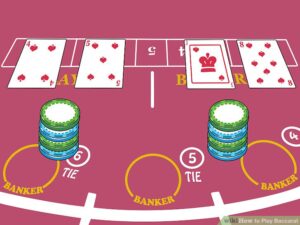

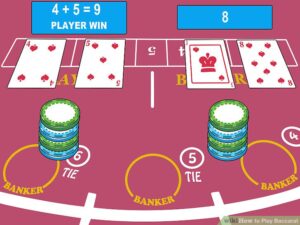



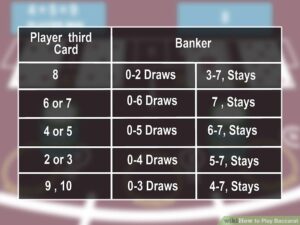

- If the Player’s third card is 9, 10, face-card or Ace, the Banker draws when he has a 0-3, and stays with a 4-7.
- If the Player’s third card is 8, the Banker draws when he has a 0-2, and stays with a 3-7.
- If the Player’s third card is 6 or 7, the Banker draws when he has a 0-6, and stays with a 7.
- If the Player’s third card is 4 or 5, the Banker draws when he has a 0-5, and stays with a 6-7.
- If the Player’s third card is 2 or 3, the Banker draws when he has a 0-4, and stays with a 5-7.
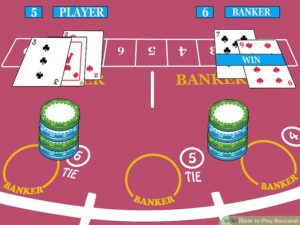



Player
If you bet on your hand winning and win, you will receive a payout of 1:1. The house has a 1.24% edge over the player.
Banker
If you bet on the Banker’s hand wining and win, you will receive a payout of 1:1. You will, however, have to pay the house a 5% commission on your winnings from the Banker’s hands. The house has a 1.06% edge over the player.


Baccarat Game Rules
Baccarat Rules A game of baccarat can have several bettors, but the gameplay boils down to one player and the dealer. The player and the dealer each receives a hand containing two cards, and the objective in baccarat is to have the hand closest to nine. To win real money in online baccarat though, participants must bet on one of three possible outcomes: the player winning, the dealer winning, or a tie. The dealer does most of the work in the game, leaving players to focus on their baccarat strategy.
Tie
If you bet on a tie and win, you will receive a payout of 8:1 (sometimes 9:1) The house, however, has a 14.36% edge over the player.
When bets are made, the dealer will draw 2 or 3 cards for the player’s and Banker’s hand. The closest hand to 9 wins.
If a hand exceeds 10, 10 is then subtracted from the hand. For example, a hand of 8 and 5 is 3 (13-10). Neither the Dealer nor the player decide if a third card is drawn. Instead, the rules of Baccarat determine this, as illustrated by the chart below.
Baccarat Card Values
Since you already know the maximum value a baccarat hand can have is nine, you’re probably wondering what to do with those ten, ace, and face cards. Unlike other casino card games, in baccarat face cards have little-to-no value. An ace is worth one point, and 10, jack, queen, and king cards are worth zero. All other cards are worth their face value.


OTHER GAMES
Dragon Tiger
Depending on whether you bet on the Dragon or the Tiger box, you win if the highest card appears on that particular option.
Poker
Any of several card games in which a player bets that the value of his or her hand is greater than that of the hands held by others, in which each subsequent player must either equal or raise the bet or drop out, and in which the player holding the highest hand at the end of the betting wins the pot
Blackjack
A card game the object of which is to be dealt cards having a higher count than those of the dealer up to but not exceeding 21.
Roulette
A gambling game in which a ball is dropped onto a revolving wheel ( roulette wheel ) with numbered compartments, the players betting on the number at which the ball will come to rest.
Craps
Craps. / (kræps) / noun(usually functioning as singular) a gambling game using two dice, in which a player wins the bet if 7 or 11 is thrown first, and loses if 2, 3, or 12 is thrown.
Sic Bo
The literal meaning of sic bo is “precious dice“, while dai siu and dai sai mean “big [or] small”.


